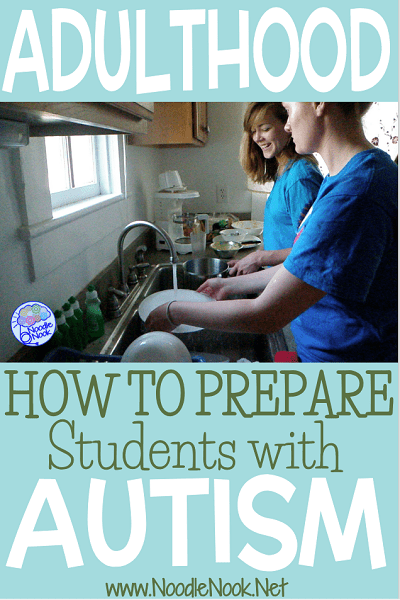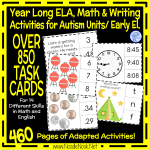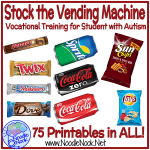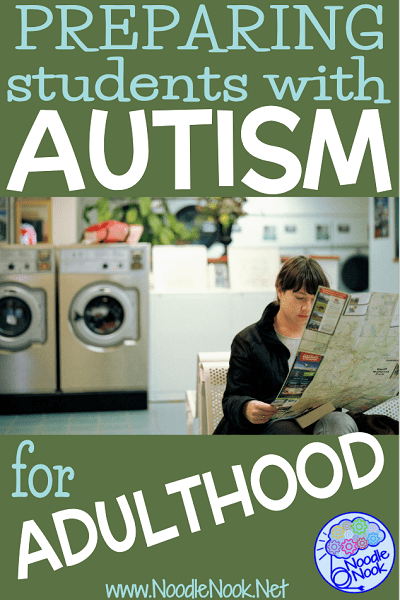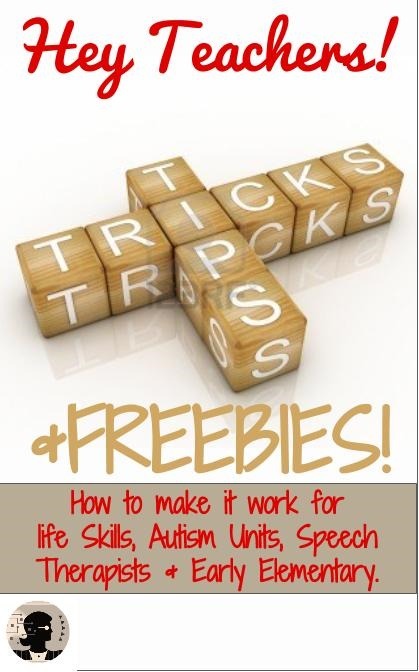As a teacher, preparing students with Autism for adulthood is hard. When you start to draft transition goals, plans, and needs for students with Autism, their ‘adulthood’ can look very different from student to student. Some will end up in residential facilities, others in sheltered workshops or dayhabs, and most in the care of family for as long as possible with a varying depth and breadth opportunities. So, when it comes to preparing students with Autism for adulthood, what are some best practices YOU should implement?
Household Needs
Schools and districts all over the country are moving away from the Craft and Cook format of self-contained classes and Autism Units of yore. The demand for real and meaningful academics is the new standard and often times it comes by eliminating functional skills.
I am lucky to be in a district that has a progressive stance on preparing students with Autism for adulthood. Where I am based, students who complete their K-12 education graduate and move on to a transition based program until they age out of the public school system. This allows the required academics to have a place of prominence as well as honor the needs our students have for functional skill building.
With that aside, no matter the format of your school’s programming, we must include the practice of functional skills. I remember the days of Home Ec and Shop Class when I was in school. At the time I thought them archaic. Now I am proud that I can sew on a button and fix things when they break.
Not everyone has that.
Household Skills Training in Action
We have to take time to teach our students some basics of household chores. This includes making their own bed, preparing a simple snack, or putting their laundry away. It also includes personal care skills. Things like bathing independently, remembering to take daily medications, and using the restroom independently are critical.
As you start preparing students with Autism for adulthood, think about what needs they will have. How can they live as independently as possible? Then think about what skills can you systematically teach to help them get there? It is all about OUTCOMES!
Transportation Needs
I live in an area without any public transportation. If you want to get somewhere, you need to know someone with a car.
Over the past decade, transportation needs were largely unmet in my area. Now, as we see the gig economy rise up to fill needs, there are more opportunities for students with Autism to travel in the community independently.
This travel can be to get to work, head out shopping, or to hang out socially. Whatever the purpose, we have to start to teach students on the transportation systems of tomorrow. We can’t rely solely on teaching kids to call a cab.
Transportation Skills Training in Action
In this day and age, that means learning to use a transportation apps. It also means deciding on cost benefits and being able to manage time to get where you need to be.
In order to become independent in any way, we have to practice. I had a friend who was an Uber driver and I asked him to be our “helper” for the day. We requested the driver, he picked up the job (as he was waiting outside).
We practiced from school how to spot the driver. We looked on the app to help identify the car. We had practiced what to say to the driver when we were in the car. We also rehearsed what to do when you got to where you were going. This is a whole new set of skills our students need in their adulthood.
Convincing parents is another job altogether.
I can remember a very vocal parent objecting to the entire idea of wasting time with Uber. No one would ever driver her daughter around other than her.
I had to honor that and we did not include her in the activity for that purpose (she was learning technology and social etiquette). You may find some parents are not onboard.
That is okay.
We, as teachers, can only do what we can do. But look to explain to parents the purpose of the lessons and what outcome you are hoping to have.
Vocational Skills
I love the parents of my students. Just as I love my students. Many years ago, I had a parent who was very involved, and I loved her to death. I consider her one of my best parents ever.
She did, however, have some slightly unrealistic expectations for her daughter. Her daughter had cognitive delays, some visual deficits, and fine motor issues. But Mom was convinced she would be a great wedding and party photographer when she got older because she liked people and people liked her. Therefore, we should be working with her on becoming a better photographer.
My face as I type this says it all…
Needless to say, I did not teach her daughter to be a better photographer…. But that was not because I didn’t think she would be successful as one. Maybe she would go on to become the best wedding photographer in all the world- that is not for me to decide.
I chose not to focus on a specific skill like that. It is not in the best interest of the student. The truth is, when she gets a job working with a real wedding photographer, that person will be the one to teach her concrete photography skills.
My job was to instill good soft skills to help her be successful no matter what job she eventually got. I had to go to the mat with mom to let her know soft skills building was the goal be increase her vocational success.
Vocational Skills Training in Action
What skills were included in that?
We wanted her to learn time management and how to transition between tasks. She need to learn how to ask for help and how to socialize appropriately at work. Learning how to self-start and how to determine the supports (visual, auditory, or otherwise) she needed to be successful.
Let’s face it… even though she loved photography today, in 10 years she may hate it and want to do something else. If that happens and we’d invested all our time into learning cameras, we’d have wasted precious years.
Not to mention, we could spend a year or two teaching her how to use a camera that will be obsolete by the time she masters it! Time management skills, however, never go out of style!
Social Skills
One of the top reasons our students do not get or keep a job is because of poor social skills. It is cited over and over as a deficit of students with Autism. It can greatly limit the ultimate level of independence our students achieve.
In the classroom, however, I see it over and over where teachers. I believe in an attempt to maintain classroom management, teachers limit the times students spend interacting socially with each other. Most social interactions for a student with Autism end up being with teachers, parents, aides, and other adults.
It seems like it is seldom with peers.
Because of that, time for building social skills is limited and deficits are plentiful. As a teacher my first few years, I did the same thing. I wanted all the students to be working and really they only talked to me or the other adult in my room.
We never did any truly social activities. Their social time was at recess and lunch… but neither of those times were structured. I never provided an opportunity for me to model, correct, and guide them through appropriate and inappropriate social interactions.
Social Skills Training in Action
Reflect on the way your classroom is structured… do you have times to socialize?
I did not.
I had to start somewhere. I started where I thought I could teach the most wide reaching skill the fastest. For me, teaching all my students what they should look like when someone is talking to them was important.
We worked for a long time on Eye Contact, Smiling, Nodding, and Listening (you can see it here and score a cute poster).
I wanted my students to be as “normal” looking (yes, I know I hate saying ‘normal’, but bear with me) as possible. When my students interacted, they were withdrawn. They looked uncomfortable sometimes or just plain inattentive.
People shortened conversations and avoided them altogether. They were just so socially awkward. Once they started looking at people, nodding and smiling a little… it was like magic. They looked more social, people were more social with them, and then they became more social.
I will say, though, I had one student over the 6 years I did this in the classroom that would smile and nod (with lots of eye cut and eye aversion) that actually looked creepy.
We pulled back on this with him and focused more on scripted exchanged to get him talking more to fill the gap. You can also score the editable speech bubbles free HERE.
That strategy worked really well for him and, in fact, even now some 4 years since I worked with him, when I see him he still uses those scripts and socializes better because of them.
The point is, no matter the strategy, you must build in more peer social interactions for your students as a way to intentionally build social skills.
Legal Stuff
I am always shocked at how many parents come to my caseload and haven’t thought about guardianship, financial obligations or chain of custody. They have no power of attorney, no plans for housing, and haven’t thought about transportation needs. Moreover, they haven’t thought about what would happen to their child if they were to (heaven forbid) be in an accident, in the hospital for some time, or pass away.
They have no plan at all.
We have to be the elephant in the room with that. We have to prod, poke, and press them. They need to make a plan, write it down, and follow through with some legal paperwork.
My cousin, who has a child with Down Syndrome, talks to me all the time about being sure their son has some financial security. He is older and knows he will pass before his son does. With that in mind, way back when, he looked to set up an annuity. It is for when the responsibility of his son’s care passed on to someone else.
He never wanted his son to be a burden.
Our parents, however, typically think they have time to get to this stuff… later. We have to be proactive and let our parents know now is the time. Add to that urgency, most social service waiting lists are literally decades long. That means waiting for later is not an option. Get on the list for services, when your number comes up, that’s when you decide if you need them.
Preparing Students with Autism for Adulthood
So, there you have it… the 5 essentials for preparing students with Autism for adulthood. We have to:
- Predict housing needs and practice functional skills
- Start using the transportation of tomorrow and practice support skills
- Build soft skills for vocational goals and future jobs
- Practice peer social interactions and build social skills
- Address a student’s future legal needs
As a case manager for a student with Autism, or any significant disability, you will have to come up with a plan with the IEP committee for transition. As a teacher in the classroom, I hope you will adopt strategies and activities that support building skills listed here. If you do, you will be preparing students with Autism for adulthood in a meaningful way.
Stay strong and teach on!


